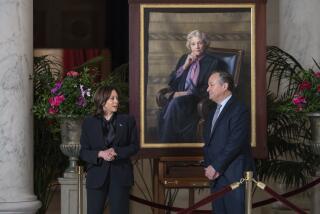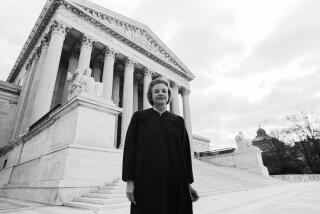Ginsburg says court is example of tolerance
- Share via
WASHINGTON — Justice Ruth Bader Ginsburg said Thursday that the change in U.S. acceptance of Jews can be seen on the Supreme Court, where two members are Jewish yet their faith played no role in their selection.
Ginsburg, appointed to the court by President Clinton in 1993, is the sixth Jewish justice. Justice Stephen G. Breyer, named the following year, is the seventh.
“Our religion had nothing to do with our appointment. It didn’t influence our choice in one way or another,” Ginsburg said.
Referring to her five Jewish predecessors, Ginsburg said, “We’re justices who happen to be Jews. We’re not Jewish justices as they were.”
Ginsburg, 74, spoke at a 100-year-old synagogue in downtown Washington about her heritage and participation in the television documentary “The Jewish Americans,” which will be broadcast over three weeks on public television.
Louis D. Brandeis, the first Jewish justice, joined the court in 1916. In the documentary, Ginsburg describes Brandeis’ encounters with anti-Semitism on the court in the person of Justice James C. McReynolds.
“McReynolds was an out-and-out anti-Semite, and he treated this brilliant man with utter disdain. When Brandeis would speak at conference, he would stand up and leave the room,” Ginsburg said.
One year, she said, there was no official court photograph because McReynolds refused to stand next to Brandeis.
“Brandeis ignored it. ‘Dignity’ is the right word to describe his response to that bigotry,” Ginsburg said.
Ginsburg was born and raised in Brooklyn, the daughter of an immigrant father and a mother born four months after her family arrived in the United States.
Ginsburg’s mother was a bookkeeper before she got married.
“What’s the difference between a bookkeeper in New York’s garment district and a U.S. Supreme Court justice?” she said in the documentary. “One generation.”
More to Read
Sign up for Essential California
The most important California stories and recommendations in your inbox every morning.
You may occasionally receive promotional content from the Los Angeles Times.













